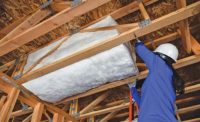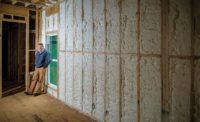According to the Department of Energy, an estimated 20 to 40 percent of a home’s utility bill could be going to waste from drafts and air leaks around openings. As temperatures cool and energy costs rise, the positive impact of energy efficiency on a building comes into focus. Air can enter and escape a structure through every gap, compromising the building envelope. Adding the right insulation and air-sealing will close these gaps, keeping interior spaces comfortable and reducing energy bills.
Additionally, today’s building industry is faced with more building codes and requirements than ever, forcing professionals to look for solutions that meet standards and project goals, while keeping costs in line with budgets.
Understanding the role spray polyurethane foam insulation can play is critical—it combats air leakage, and completely fills all gaps and voids to optimize a building’s performance. The following are some things to know about working with spray foam insulation.
1. Benefits: Fast, Effective Application
SPF application is fast and effective. Unlike traditional insulation types like fiberglass, which require a separate air-sealing step, spray foam can air seal and insulate a structure in one step, thus keeping the project moving forward. Combining these steps coupled with a spray-on application decreases installation time and delivers the ability to fit into hard-to-reach places, like eaves, odd-sized cavities, and rims. In addition to installation efficiencies, spray foam can provide excellent thermal, acoustical and indoor air quality performance in any climate.
Spray foam can also contribute to more comfortable interior spaces and less costly monthly energy bills. The U.S. Environmental Protection Agency estimates homeowners can save an average of 15 percent on heating and cooling costs by air sealing their homes and adding insulation in attics, floors over crawl spaces, and accessible basement rim joints.
Spray foam insulation systems effectively seal walls, roofs, corners and other surfaces, creating a more comfortable household because it provides a barrier against drafts and associated pollen and dust. Long-term, properly installed spray foam won’t change its form or shape, meaning it will deliver the same benefits that it did years—or even decades—after being installed, while other insulation materials may settle and create future gaps in the insulation.
2. Open-cell vs. Closed-cell— What’s the Difference?
There are two main types of spray foam to consider: open-cell and closed-cell. Open-cell spray foam has a lower R-value per inch and because of this, typically a lower price tag. The soft, low-density material is used for interior applications. Its high permeability allows for moisture to pass through, which contributes to bi-directional drying of the assembly, but it may not be ideal for all applications or climates.
Closed-cell foam has a higher density and offers a higher R-value per inch. It also adds strength to walls, ceilings and roofs and can contribute to a structure’s overall durability. Additionally, closed-cell foam’s low water vapor permeability offers protection from moisture when installed in places where high humidity—from climate, occupants, or flooding—meets the structure.
Determining which type of SPF is right for the project involves evaluating the application area, overall budget, and scope of a project. Review insulation needs in attics, walls, ceilings, and other areas, and account for factors like project location, climate and how the building will be used. For example, an indoor swimming pool will drive towards a different SPF selection than an office building.
3. Combining Spray Foam With Other Insulation Products is Cost and Energy-efficient
Spray foam’s thermal performance and advanced air and moisture control can be optimized by combining it with other insulation products like fiberglass batts or rolls, maximizing budget and meeting energy efficiency goals. Combining insulation products creates a custom solution by leveraging the functions of multiple materials to find the best mix for the project.
For example, a hybrid solution of spray foam and fiberglass batts or rolls combines the air-sealing and vapor-retarder benefits of foam with the economical thermal performance of fiberglass. Another option might be to install spray foam in places that are hard to reach or seal, such as rim joists, the attic floor, and eaves, and then install fiberglass batts and loose-fill in the in the open areas, greatly reducing any draftiness while helping the project budget. Incorporating spray foam into hybrid solutions enhances the building envelope and seals efficiently at a reasonable cost.
A well-insulated and sealed building envelope can significantly contribute to optimal energy efficiency. As with any project, to fully utilize the benefits of spray foam, attention to detail and proper installation is crucial. It’s important to take appropriate time or seek aid through outside expertise to understand how all types of insulation products can work together within the construction of a home or building and the surrounding environment. When installed correctly, spray foam has the potential to be one of the most effective choices for insulation solutions.









Report Abusive Comment